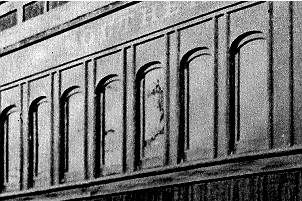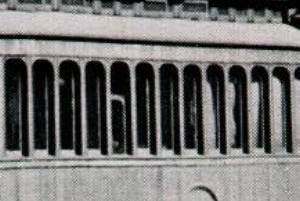N SName panel. A panel, often of a circular or elliptical form, on the outside of a passenger car body below the windows, on which the name or number of the car is usually painted. Generally surrounded by a wooden molding. Pantasote. A variety of surface-coated upholstery material which now might be called leatherette or imitation leather. It had a unique surface coating that could withstand exposure to gasoline and oils. Thus, it became one of the favored choices of car makers throughout North America. Pantasote offered the standard black surface coating (with at least a few choices of embossing patterns by the mid-teens) as well as brown and two shades of red. The latter three options apparently had limited use, but set the brand apart in this regard. Pantasote seems to have been an exclusive producer of surface-coated double texture prior to 1914. Even with numerous competitors in this construction after 1914, Pantasote maintained a strong position in the car top material field into the 1930s. The trade name was used generically for surface-coated, double texture toppings. Paper Wheels. (Has its own page.) (Or should we say have their own page?) Plan 73, 73A, etc. The Pullmans Palace Car Company apparently had a number of plans by which it built cars for different railroads. The plan may have been nothing more than a floor plan and window layout, but it may have been much more than that. Authorities do not agree. Platform roof. Extension of the main roof of the car that projects over and covers the end platform to protect passengers from rain and snow. When it is separate from the main roof it is called a platform hood. Probably the primary feature for identifying passenger cars, although sometimes misleading, as they were occasionally rebuilt if a car body survived long enough. Types of platform roofs are
Rafter. (See Carline.) Roof apron. (below) Fascia attached to the end of a passenger car roof, sometimes projecting downward to prevent cinders, rain or snow from being driven onto the end platform or into the door-way. Usually connects the letter-board on one side of the car to that on the other. It normally has an arch to it, as in the photo below, but on the hooded platform roof, it goes almost straight across or appears to be absent (see photo immediately above).
Short Carline. (See Carline.) Side Bearings. Supporting bearings placed outboard of the center-pin [also known as a king-bolt or king pin] of a car to stabilize the body as it moves down the track. These generally consist of a body side bearing and a truck side bearing. The body side bearing is usually a plate of iron or steel attached to the body bolster on each side of the center-pin, while the truck side bearing is a corresponding plate, block or roller on the truck bolster. There may be a small space left between the two so that the truck can turn freely on the center-plate. Single-pane window. (below) Window with only one pane of glass. The window sash may open up or down. If there is significant space above the window, it probably opens up. If not, it probably opens down. Very few cars had single-pane windows, and very, very few had windows opening down, as it interfered with the framing of the side wall truss.
Stake. A stick of wood (but much heavier than the word stick implies) attached vertically to the outside of a flat car by means of a stake pocket to keep the load from falling off. Stake pocket. A cast-iron receptacle attached to the side of a flat car to receive the end of a stake. |



